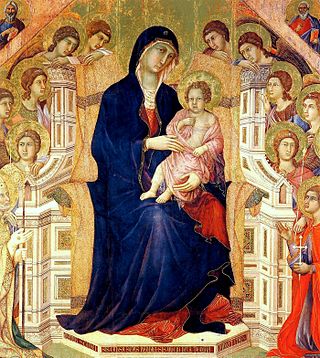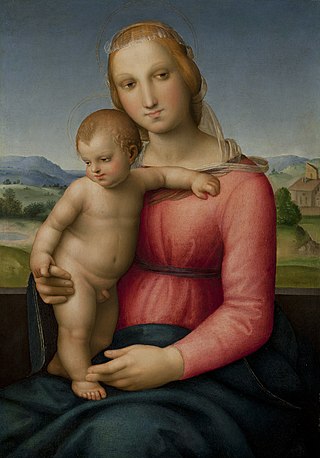
Duccio di Buoninsegna, commonly known as just Duccio, was an Italian painter active in Siena, Tuscany, in the late 13th and early 14th century. He was hired throughout his life to complete many important works in government and religious buildings around Italy. Duccio is considered one of the greatest Italian painters of the Middle Ages, and is credited with creating the painting styles of Trecento and the Sienese school. He also contributed significantly to the Sienese Gothic style.

Lorenzo Lotto was an Italian Renaissance painter, draughtsman, and illustrator, traditionally placed in the Venetian school, though much of his career was spent in other north Italian cities. He painted mainly altarpieces, religious subjects and portraits. He was active during the High Renaissance and the first half of the Mannerist period, but his work maintained a generally similar High Renaissance style throughout his career, although his nervous and eccentric posings and distortions represented a transitional stage to the Florentine and Roman Mannerists.

Carlo Crivelli was an Italian Renaissance painter of conservative Late Gothic decorative sensibility, who spent his early years in the Veneto, where he absorbed influences from the Vivarini, Squarcione, and Mantegna. He left the Veneto by 1458 and spent most of the remainder of his career in the March of Ancona, where he developed a distinctive personal style that contrasts with that of his Venetian contemporary Giovanni Bellini.

Madonna and Child was painted by one of the most influential artists of the late 13th and early 14th century, Duccio di Buoninsegna. This iconic image of the Madonna and Child, seen throughout the history of western art, holds significant value in terms of stylistic innovations of religious subject matter that would continue to evolve for centuries.

The Madonna Litta is a late 15th-century painting, by Leonardo da Vinci, in the Hermitage Museum, Saint Petersburg. It depicts the Virgin Mary breastfeeding the Christ child, a devotional subject known as the Madonna lactans. The figures are set in a dark interior with two arched openings, as in Leonardo's earlier Madonna of the Carnation, and a mountainous landscape in aerial perspective can be seen beyond. In his left hand Christ holds a goldfinch, which is symbolic of his future Passion.

Raffaellino del Garbo (1466–1527) was a Florentine painter of the early Renaissance.

Jules Semon Bache was an American banker, art collector and philanthropist.

Giovanni Antonio Boltraffio was an Italian painter of the High Renaissance from Lombardy, who worked in the studio of Leonardo da Vinci. Boltraffio and Bernardino Luini are the strongest artistic personalities to emerge from Leonardo's studio. According to Giorgio Vasari, he was of an aristocratic family and was born in Milan.

Giampietrino, probably Giovanni Pietro Rizzoli, was a north Italian painter of the Lombard school and Leonardo's circle, succinctly characterized by S. J. Freedberg as an "exploiter of Leonardo's repertory."

Portrait of a Carthusian is a painting in oils on oak panel by the Early Netherlandish painter Petrus Christus in 1446. The work is part of the Jules Bache Collection housed at the Metropolitan Museum of Art in New York City.

Bernardino de 'Conti was an Italian Renaissance painter, born in 1465 in Castelseprio and died around 1525.

Virgin and Child with Four Angels is a small oil-on-panel painting by the Early Netherlandish artist Gerard David. Likely completed between 1510 and 1515, it shows the Virgin Mary holding the child Jesus, while she is crowned Queen of Heaven by two angels above her, accompanied by music provided by another two angels placed at either side of her. In its fine detail and lush use of colour the work is typical of both David and late period Flemish art.

The Madonna and Child with the Infant Saint John the Baptist is a lost composition by Leonardo da Vinci. The composition is known through a handful of paintings attributed to artists in Leonardo's circle. An original underdrawing by Leonardo may be preserved in a version in a private collection in Moscow, Russia.

The Virgin and Child, commonly known as The Northbrook Madonna after the Northbrook Collection in England, is a painting from the early 16th century by an unknown artist possibly identified as Domenico Alfani. It is in the permanent collection of the Worcester Art Museum in Worcester, Massachusetts, United States. It was formerly attributed to Raphael, but scholars have since concluded otherwise.

Mother and Child (The Oval Mirror) is an oil-on-canvas painting by the American Impressionist artist Mary Cassatt. The painting depicts a mother and her child in front of a mirror. The painting provides a glimpse of the domestic life of a mother and her child, evoking religious iconography from the Italian Renaissance. However, portrayals of a mother and her child are common in Cassatt's work, so it is possible that this similarity is coincidental rather than intentional.

The Lehman Madonna is a c.1470 tempera-on-panel painting of the Madonna and Child by the Venetian painter Giovanni Bellini.

Christ with a Staff or St James the Less is a painting by a follower of Rembrandt, now in the Metropolitan Museum of Art. It was also known as Christ in 1854 and exhibited in 1933 as The Pilgrim.

The Lenti Madonna or Bache Madonna is a tempera and gold on panel painting by the Italian Renaissance painter Carlo Crivelli, executed c. 1472–1473, and signed OPVS KAROLI CRIVELLI VENETI. It is now in the Metropolitan Museum of Art in New York, which it entered in 1944.

Annunciation is an oil on alabaster painting by Orazio Gentileschi, from c. 1600-1605, later mounted on slate. Produced in Rome for an unknown private commissioner, it is now in Álvaro Saieh and Ana Guzmán's residence as part of the Alana collection in Newark, Delaware, USA.

The Kedleston Madonna is a c.1529 oil on canvas painting by Parmigianino, now in the Kimbell Art Museum in Fort Worth, Texas, which acquired it from the Kedleston collection in the United Kingdom in 1995.




















